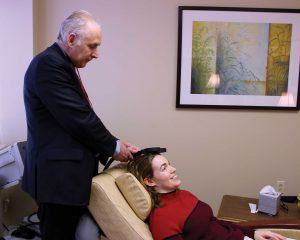Bob Cronin says depression is like a dark cloud that renders him unable to function.
“I don’t want to do anything,” says the 67-year-old, describing the debilitating condition he’s battled for 15 years. “I become rude. I become cold. I don’t want to interact.” Even eating and brushing his teeth can be a struggle, he explains.
Cronin tried various treatments over the years, which either didn’t work or brought substantial risks and side effects. But now, the husband and grandfather says he’s finally found ongoing relief through an innovative treatment that’s helping people across SJ and beyond.
The procedure, called transcranial magnetic stimulation (TMS), “is life-changing and life-saving,” says Bob, an actor and retired teacher.

Dr. John O’Reardon demonstrates TMS
TMS uses magnetic pulses to stimulate part of the brain – the left prefrontal cortex – that helps regulate mood and handle decision-making. The area is often less active in people with major depression.
“It’s like when a program in a com-puter is offline,” says TMS expert John O’Reardon, MD, a psychiatrist with Rowan University School of Osteopathic Medicine. “We re-energize the neurons, which brings the circuits back online.”
The result: More than half of patients feel much better or are no longer depressed, according to O’Reardon, director of Rowan’s Center for Mood Disorders and Neuromodulation Therapies in Cherry Hill. What’s more, TMS is only recommended for those who haven’t responded to one or more courses of antidepressants. By comparison, antidepressants are effective in only about 15 percent of such “treatment-resistant” patients, explains O’Reardon. (TMS treatment has not been thoroughly studied for people who have failed two or more trials of antidepressants or for people who have not been on antidepressants, according to the National Alliance on Mental Illness.)
“The level of response [to TMS] varies,” he adds. Patients who receive ongoing maintenance treatments “do better over time, have fewer mini-setbacks and are more stable.”
TMS treatment is non-invasive and as convenient as going to the doctor’s office. The patient sits in a recliner while the physician or nurse holds a wand to a precise spot on the patient’s head. The wand, connected to a microwave-size machine on a cart, delivers a series of electromagnetic pulses to the left side of the forehead – 50 pulses in five seconds, then a 15-second rest before the next set. The pulses pass through the skull, landing at their target in the brain. Each treatment session lasts about 25 minutes – delivering a total of 4,000 pulses – and no recovery period is needed. The magnetic field is the same strength as a typical MRI scan – 1.5 to 2 Teslas, O’Reardon notes.
The pulses cause a prickly, tingling sensation where the wand touches the skin. Patients hear a tapping sound, but they can talk, read or use headphones during the treatment.
Some people get soreness on their scalp. Patients can also get a headache, usually right after treatment, but the pain is typically mild and brief, says Amanda Helmer, RN, TMS program coordinator for the Rowan mood center.
There’s a small risk of seizure during treatment – less than one in 10,000 patients, she says. (That side effect has never occurred to one of his patients over O’Reardon’s 17 years of TMS research and clinical practice, he reports.) Also, because the treatment is relatively new, long-term side effects are unknown, cautions the National Institute of Mental Health.
O’Reardon recommends that patients initially undergo five sessions per week for six weeks, for a total of 30 sessions “when trying to get out of the hole of depression. Some may only need 20 sessions; some may need more.”
Cronin received his initial treatments in 2008, and is now on a maintenance schedule of one session every two weeks.
“My wife knows when I’ve missed a treatment,” says the genial former theater-department head for a Philadelphia-area prep school. “TMS brings me back to the person I was before my depression started getting really bad.”
About 40 percent of patients, like Cronin, stay on a maintenance schedule of treatments indefinitely.
“Some people are afraid to stop, because they felt so lousy before,” notes O’Reardon.
Cronin continues to receive talk therapy as well to help address his long-term goals and organize his life. “TMS sets you up and gets you going. Talk therapy makes you enter the world again,” he says. “It’s like, ‘Now that you’re feeling better, what are you going to do?’
“I can feel the cloud pushing back,” Cronin adds. “It’s like all of a sudden you get this blast of positive energy. Life is good; you’re not in a fog.”











